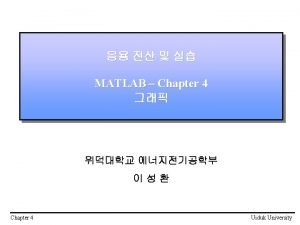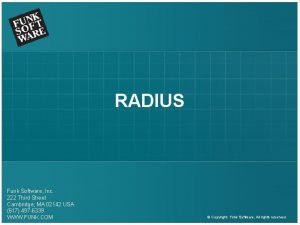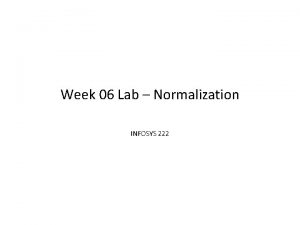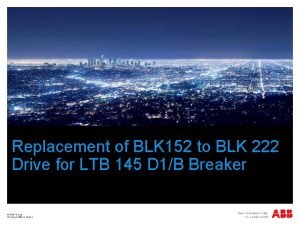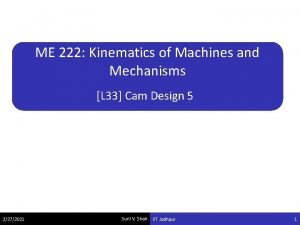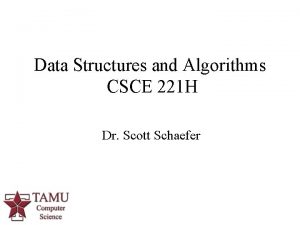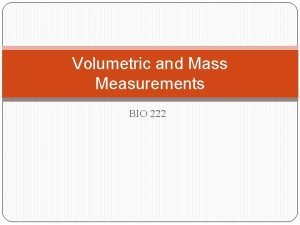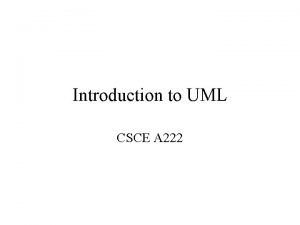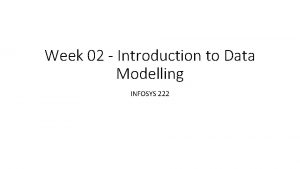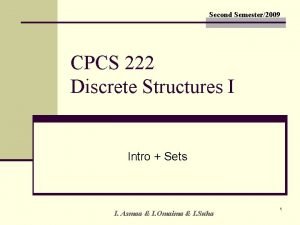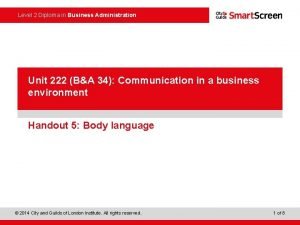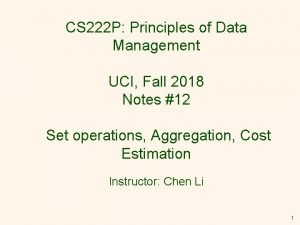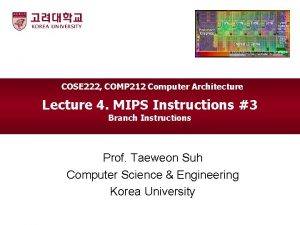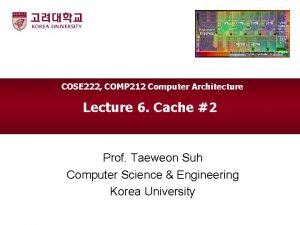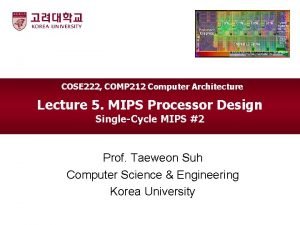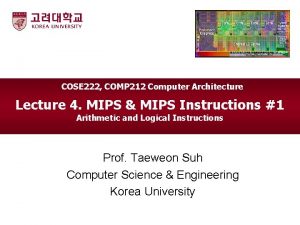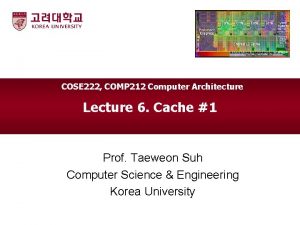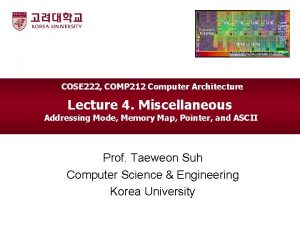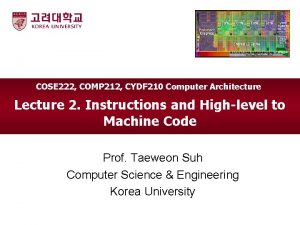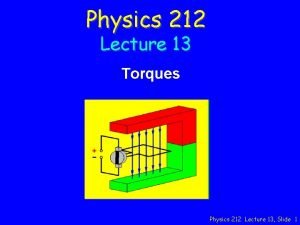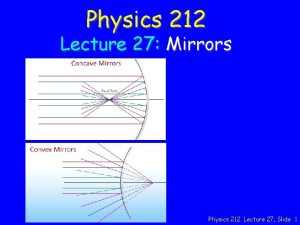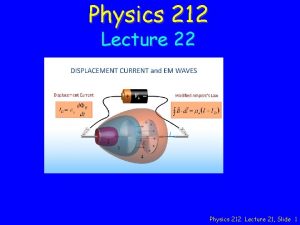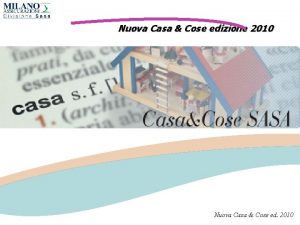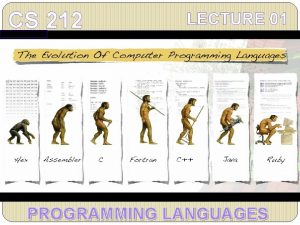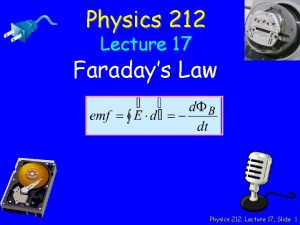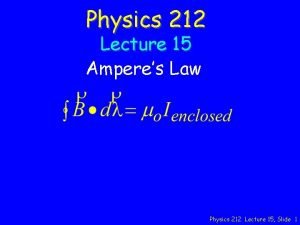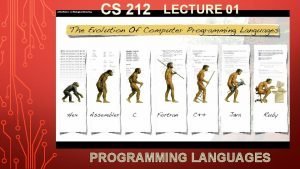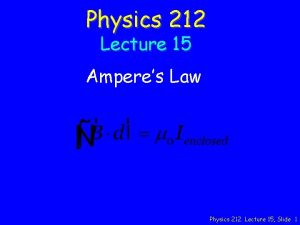COSE 222 COMP 212 Computer Architecture Lecture 5



















![Register File in Verilog module regfile(input [4: 0] input [31: 0] output [31: 0] Register File in Verilog module regfile(input [4: 0] input [31: 0] output [31: 0]](https://slidetodoc.com/presentation_image_h/99220d135a9fa4cac0f41a7466da7b62/image-20.jpg)



![How to Design Mux in Verilog? module mux 2 (input [31: 0] d 0, How to Design Mux in Verilog? module mux 2 (input [31: 0] d 0,](https://slidetodoc.com/presentation_image_h/99220d135a9fa4cac0f41a7466da7b62/image-24.jpg)














- Slides: 38

COSE 222, COMP 212 Computer Architecture Lecture 5. MIPS Processor Design Single-cycle MIPS #1 Prof. Taeweon Suh Computer Science & Engineering Korea University

Introduction • Microarchitecture means the CPU internal hardware structure, which of course understands machine code and is able to execute it • Multiple microarchitectures for an ISA § Single-cycle • Each instruction is executed in a single cycle • It suffers from the long critical path delay, limiting the clock frequency § Multi-cycle • Execution is broken up into a series of steps • Different instructions use different numbers of steps, so simpler instructions completes faster than more complex ones § Pipeline • Execution is broken up into a series of steps • All the instructions use the same number of steps • Multiple instructions are executed simultaneously 2 Korea Univ

Revisiting Performance CPU Time = # insts X CPI X clock cycle time (T) = # insts X CPI / f • Performance depends on § § § Algorithm affects the instruction count Programming language affects the instruction count and CPI Compiler affects the instruction count and CPI Instruction set architecture affects the instruction count, CPI, and T (f) Microarchitecture (Hardware implementation) affect CPI and T (f) Semiconductor technology affects T (f) • Challenges in designing microarchitecture is to satisfy constraints of cost, power and performance 3 Korea Univ

Revisiting Digital Logic Design Basics • Combinational logic § Output is directly determined by current input AND gate A B A Y + ALU Multiplexer (Mux) Adder I 0 I 1 Y B M u x S Y A ALU Y B F • Sequential logic § Output is determined not only by current input, but also internal state (i. e. , previous inputs) § Sequential logic needs state elements to store information • Flip-flops and latches are used to store the state information. But, avoid using latch in digital design 4 Korea Univ

Revisiting State Element • Registers (implemented with flip-flops) store data in a circuit § Clock signal determines when to update the stored value • Rising-edge triggered: update when clock changes from 0 to 1 • Falling-edge triggered: update when clock changes from 1 to 0 § Data input determines what (0 or 1) to update to the output D Flip-flop D Clk Q • Register with write control (or enable) § Only updates on clock edge when write control (enable) input is 1 D Write Clk Q Clk Write D Q 5 Korea Univ

Clocking Methodology • Virtually all digital systems are synchronous to the clock • Combinational logic sits between state elements (flip-flops) • Combinational logic produces its intended data during clock cycles § Input from state elements § Output to the next state elements § Longest delay determines the clock period (frequency) 6 Korea Univ

Overview • We are going to design a MIPS CPU that is able to execute the machine code we discussed so far • For the sake of your understanding, we simplify the CPU and its system structure Real-PC system CPU FSB (Front-Side Bus) Main Memory (DDR) Address Bus Simplified MIPS CPU North Bridge Data Bus DMI (Direct Media I/F) Memory (Instruction, data) South Bridge 7 Korea Univ

Our MIPS Model • Our MIPS CPU model has separate connections to memory § Actually, this structure is more realistic as we will see when we study caches Instruction fetch Address Bus Data Bus MIPS CPU Address Bus Instruction/ Data Memory Data Bus Data access • We use both structural and behavioral modeling with Verilog-HDL § Behavioral modeling descriptively specifies what a module does • For example, the lowest modules (such as ALU and register files) are designed with the behavioral modeling § Structural modeling describes a module from simpler modules via instantiations • For example, the top module (such as mips. v) are designed with the structural modeling 8 Korea Univ

Overview • Microarchitecture is composed of datapath and control § Datapath operates on words of data • Datapath elements are used to operate on or hold data within a processor • In MIPS implementation, datapath elements include the register file, ALU, muxes, and memory § Control tells the datapath how to execute instructions • Control unit receives the current instruction from memory and tells the datapath how to execute that instruction • Specifically, the control unit produces mux select, register enable, ALU control, and memory write signals to control the operation of the datapath • Our MIPS implementation is simplified by designing only § Data processing instructions: add, sub, and, or, slt § Memory access instructions: lw, sw § Branch instructions: beq, j 9 Korea Univ

Overview of Our Design MIPS_System_tb. v (testbench) MIPS_System. v reset mips. v ram 2 port_inst _data. v Address clock fetch, pc Decoding Register File ALU Memory Access Instruction Address Code and Data in your program Data. Out Data. In 10 Korea Univ

Instruction Execution in CPU • Generic steps of the instruction execution in CPU § Fetch uses the program counter (PC) to supply the instruction address and fetch instruction from memory § Decoding decodes instruction and reads operands • Extract opcode: determine what operation should be done • Extract operands: register numbers or immediate from fetched instruction § Execution • Use ALU to calculate (depending on instruction class) § Arithmetic or logical result § Memory address for load/store § Branch target address • Access memory for load/store MIPS CPU Fetch with PC PC = PC +4 Address Bus Data Bus Address Bus § Next Fetch Execute • PC target address or PC + 4 Decode Instruction/ Data Memory Data Bus 11 Korea Univ

Instruction Fetch MIPS CPU Increment by 4 for the next instruction 4 Add Memory reset clock Address PC Out 32 instruction 32 -bit register (flip-flops) • What is PC on reset? § MIPS initializes PC to 0 x. BFC 0_0000 § For the sake of simplicity, let’s initialize the PC to 0 x 0000_0000 in our design 12 Korea Univ

Instruction Fetch Verilog Model mips. v 4 pcnext module mips( input clk, input reset, output[31: 0] pc); Adder pc reset clock pcreg module pcreg ( input clk, input reset, output reg [31: 0] pc, input [31: 0] pcnext); always @(posedge clk, posedge reset) begin if (reset) pc <= 32'h 0000; else pc <= pcnext; end wire [31: 0] pcnext; module myadder( input [31: 0] a, input [31: 0] b, output [31: 0] y); assign y = a + b; // instantiate pc pcreg mips_pc (. clk (clk), . reset (reset), . pc (pc), . pcnext(pcnext)); // instantiate adder myadder pcadd 4 (. a (pc), . b (32'b 100), . y (pcnext)); endmodule 13 Korea Univ

Memory • As studied in the Computer Logic Design, memory is classified into RAM (Random Access Memory) and ROM (Read-Only Memory) § RAM is classified into DRAM (Dynamic RAM) and SRAM (Static RAM) § DDR is a kind of DRAM • DDR is a short form of DDR (Double Data Rate) SDRAM (Synchronous DRAM) • DDR is used as main memory in modern computers • We use a Cyclone-II (Altera FPGA)-specific memory model because we port our design to the Cyclone-II FPGA 14 Korea Univ

Generic Memory Model in Verilog 64 words Word (32 -bit) Compiled binary file module mem(input clk, input [7: 2] input [31: 0] output [31: 0] reg Mem. Write, Address, Write. Data, Read. Data); [31: 0] RAM[63: 0]; // Memory Initialization initial begin $readmemh("memfile. dat", RAM); end // Memory Read assign Read. Data = RAM[Address[7: 2]]; // Memory Write always @(posedge clk) begin if (Mem. Write) RAM[Address[7: 2]] <= Write. Data; end Memory 20020005 2003000 c 32 2067 fff 7 00 e 22025 00642824 00 a 42820 Write. Data[31: 0] 10 a 7000 a 0064202 a 10800001 20050000 00 e 2202 a Read. Data[31: 0] 00853820 00 e 23822 ac 670044 32 8 c 020050 6 08000011 20020001 ac 020054 Address endmodule memfile. dat 15 Korea Univ

Simple MIPS Test Code assemble 16 Korea Univ

Our Memory • As mentioned, we use a Cyclone-II (Altera FPGA)-specific memory model because we port our design to the Cyclone-II FPGA § Prof. Suh has created a memory model using Mega. Wizard in Quartus -II § To initialize the memory, it requires a special format called mif § Prof. Suh wrote a perl script to generate the mif-format file • Check out Makefile § For synthesis and simulation, just copy insts_data. mif to MIPS_System_Syn and MIPS_System_Sim directories 17 Korea Univ

Instruction Decoding • Instruction decoding separates the fetched instruction into the fields according to the instruction types (R, I, and J types) § Opcode and funct fields determine which operation the instruction wants to do • Control logic should be designed to supply control signals to datapath elements (such as ALU and register file) § Operands • Register numbers in the instruction are sent to the register file • Immediate field is either sign-extended or zero-extended depending on instructions 18 Korea Univ

Schematic with Instruction Decoding MIPS CPU Core Opcode funct Control Unit sign_ext Reg. Write Register File ra 1[4: 0] R 0 32 rd 1 32 rd 2 R 1 R 2 ra 2[4: 0] R 3 instruction wa[4: 0] … wd 32 R 30 R 31 Reg. Write Memory imm 16 Sign or zeroextended 4 32 Add Out 32 reset clock sign_ext 19 PC Address Korea Univ
![Register File in Verilog module regfileinput 4 0 input 31 0 output 31 0 Register File in Verilog module regfile(input [4: 0] input [31: 0] output [31: 0]](https://slidetodoc.com/presentation_image_h/99220d135a9fa4cac0f41a7466da7b62/image-20.jpg)
Register File in Verilog module regfile(input [4: 0] input [31: 0] output [31: 0] clk, Reg. Write, ra 1, ra 2, wa, wd, rd 1, rd 2); 32 bits ra 1[4: 0] reg [31: 0] rf[31: 0]; // // Register File three ported register file read two ports combinationally write third port on rising edge of clock register 0 hardwired to 0 ra 2[4: 0] wa wd always @(posedge clk) if (Reg. Write) rf[wa] <= wd; 5 R 0 5 R 1 R 2 32 rd 1 R 3 5 … 32 R 30 32 rd 2 R 31 Reg. Write assign rd 1 = (ra 1 != 0) ? rf[ra 1] : 0; assign rd 2 = (ra 2 != 0) ? rf[ra 2] : 0; endmodule 20 Korea Univ

Sign & Zero Extension in Verilog Why declares it as reg? Is it going to be synthesized as registers? Is this logic combinational or sequential logic? module sign_zero_ext(input sign_ext, input [15: 0] a, output reg [31: 0] y); a[15: 0] (= imm) always @(*) begin if (sign_ext) y <= {{16{a[15]}}, a}; else y <= {{16{1'b 0}}, a}; end 16 Sign or zeroextended y[31: 0] 32 sign_ext endmodule 21 Korea Univ

Instruction Execution #1 • Execution of the arithmetic and logical instructions § R-type arithmetic and logical instructions • Examples: add, sub, and, or. . . • 2 source operands from the register file add opcode rs $t 0, $s 1, $s 2 rt rd sa funct § I-type arithmetic and logical instructions • Examples: addi, andi, ori. . . destination register • 1 source operand from the register file • 1 source operand from the immediate field addi opcode rs $t 0, $s 3, -12 immediate rt 22 Korea Univ

Schematic with Instruction Execution #1 MIPS CPU Core Opcode funct Control Unit ALUSrc Reg. Write Register File ra 1[4: 0] ra 2[4: 0] R 0 32 rd 1 R 2 ALUSrc R 3 instruction wa[4: 0] … wd 32 R 30 32 ALU rd 2 mux R 31 Reg. Write Memory imm 16 Sign or zeroextended 4 32 Add Out 32 reset clock 23 PC Address Korea Univ
![How to Design Mux in Verilog module mux 2 input 31 0 d 0 How to Design Mux in Verilog? module mux 2 (input [31: 0] d 0,](https://slidetodoc.com/presentation_image_h/99220d135a9fa4cac0f41a7466da7b62/image-24.jpg)
How to Design Mux in Verilog? module mux 2 (input [31: 0] d 0, input [31: 0] d 1, input s, output [31: 0] y); module mux 2 (input [31: 0] d 0, input [31: 0] d 1, input s, output reg [31: 0] always @(*) begin if (s) y <= d 1; else y <= d 0; endmodule OR assign y = s ? d 1 : d 0; endmodule Design it with parameter, so that this module can be used (instantiatiated) in any sized muxes in your design y); module datapath(………); wire [31: 0] writedata, signimm; wire [31: 0] srcb; wire alusrc module mux 2 #(parameter WIDTH = 8) (input [WIDTH-1: 0] d 0, d 1, input s, output [WIDTH-1: 0] y); assign y = s ? d 1 : d 0; endmodule // Instantiation mux 2 #(32) srcbmux(. d 0 (writedata), . d 1 (signimm), . s (alusrc), . y (srcb)); endmodule 24 Korea Univ

Instruction Execution #2 • Execution of the memory access instructions § lw, sw instructions lw opcode sw opcode $t 0, 24($s 3) // $t 0 <= [$s 3 + 24] rs rt $t 2, 8($s 3) rs immediate // [$s 3 + 8] <= $t 2 rt immediate 25 Korea Univ

Schematic with Instruction Execution #2 MIPS CPU Core Opcode funct Mem. Write Memto. Reg ALUSrc Reg. Write Control Unit Mem. Write Memory Register File ra 1[4: 0] ra 2[4: 0] R 0 Write. Data 32 rd 1 Read. Data R 1 R 2 ALUSrc R 3 instruction wa[4: 0] wd 32 … 32 ALU Address rd 2 Memto. Reg mux R 30 R 31 mux Memory imm 16 Sign or zeroextended 4 Out 32 reset clock lw sw $t 0, 24($s 3) // $t 0 <= [$s 3 + 24] $t 2, 8($s 3) // [$s 3 + 8] <= $t 2 32 Add 26 PC Address Korea Univ

Instruction Execution #3 • Execution of the branch and jump instructions § beq, bne, j, jal, jr instructions beq $s 0, $s 1, Lbl opcode rs // go to Lbl if $s 0=$s 1 rt immediate Destination = (PC + 4) + (imm << 2) j target opcode // jump target Destination = {(PC+4)[31: 28] , jump target, 2’b 00} 27 Korea Univ

Schematic with Instruction Execution #3 (beq) MIPS CPU Core Opcode funct branch Control Unit Mem. Write PCSrc zero Memory Register File ra 1[4: 0] ra 2[4: 0] R 0 Write. Data 32 rd 1 Read. Data R 1 R 2 ALUSrc R 3 wa[4: 0] instruction wd 32 … 32 ALU Address rd 2 Memto. Reg mux R 30 R 31 mux PCSrc mux imm 16 Add Sign or zeroextended Memory 4 32 Out reset clock Destination = (PC + 4) + (imm << 2) 32 Add <<2 28 PC Address Korea Univ

Schematic with Instruction Execution #3 (j) MIPS CPU Core Opcode funct jump Control Unit branch Mem. Write PCSrc zero Memory Register File ra 1[4: 0] ra 2[4: 0] R 0 Write. Data 32 rd 1 Read. Data R 1 R 2 ALUSrc R 3 wa[4: 0] instruction wd 32 … 32 ALU Address rd 2 Memto. Reg mux R 30 R 31 mux PCSrc jump mux imm 16 imm 26 Sign or zeroextended <<2 32 Add mux Memory 4 32 Add Out <<2 28 Concatenation reset clock PC Address PC[31: 28] Destination = {(PC+4)[31: 28], jump target, 2’b 00} 29 Korea Univ

Demo • Synthesis with Quartus-II • Simulation with Model. Sim 30 Korea Univ

Backup Slides 31 Korea Univ

Why HDL? • In old days (~ early 1990 s), hardware engineers used to draw schematic of the digital logic, based on Boolean equations, FSM, and so on… • But, it is not virtually possible to draw schematic as the hardware complexity increases § Example: • Number of transistors in Core 2 Duo is roughly 300 million • Assuming that the gate count is based on 2 -input NAND gate, (which is composed of 4 transistors), do you want to draw 75 million gates by hand? Absolutely NOT! 32 Korea Univ

Why HDL? • Hardware description language (HDL) § Allows designer to specify logic function using language • So, hardware designer only needs to specify the target functionality (such as Boolean equations and FSM) with language § Then a computer-aided design (CAD) tool produces the optimized digital circuit with logic gates • Nowadays, most commercial designs are built using HDLs HDL-based Design CAD Tool Optimized Gates module example( input a, b, c, output y); assign y = ~a & ~b & ~c | a & ~b & c; endmodule 33 Korea Univ

HDLs • Two leading HDLs § Verilog-HDL • Developed in 1984 by Gateway Design Automation • Became an IEEE standard (1364) in 1995 • We are going to use Verilog-HDL in this class § The book on the right is a good reference (but not required to purchase) § VHDL • Developed in 1981 by the Department of Defense • Became an IEEE standard (1076) in 1987 n IEEE: Institute of Electrical and Electronics Engineers is a professional society responsible for many computing standards including Wi. Fi (802. 11), Ethernet (802. 3) etc 34 Korea Univ

HDL to (Logic) Gates • There are 3 steps to design hardware with HDL 1. Hardware design with HDL • Describe your hardware with HDL § When describing circuits using an HDL, it’s critical to think of the hardware the code should produce 2. Simulation • Once you design your hardware with HDL, you need to verify if the design is implemented correctly § § § Input values are applied to your design with HDL Outputs checked for correctness Millions of dollars saved by debugging in simulation instead of hardware 3. Synthesis • Transforms HDL code into a netlist, describing the hardware § Netlist is a text file describing a list of logic gates and the wires connecting them 35 Korea Univ

CAD tools for Simulation • There are renowned CAD companies that provide HDL simulators § Cadence • www. cadence. com § Synopsys • www. synopsys. com § Mentor Graphics • www. mentorgraphics. com • We are going to use Model. Sim Altera Starter Edition for simulation • http: //www. altera. com/products/software/quartus-ii/modelsim/qts-modelsimindex. html 36 Korea Univ

CAD tools for Synthesis • The same companies (Cadence, Synopsys, and Mentor Graphics) provide synthesis tools, too § They are extremely expensive to purchase though • We are going to use a synthesis tool from Altera § Altera Quartus-II Web Edition (free) • Synthesis, place & route, and download to FPGA • http: //www. altera. com/products/software/quartus-ii/web-edition/qts-weindex. html 37 Korea Univ

MIPS CPU with imem and Testbench module mips_tb(); reg module mips_cpu_mem(input clk, reset); wire [31: 0] pc, instr; // instantiate processor and memories mips_cpu imips_cpu (clk, reset, pc, instr); imem imips_imem (pc[7: 2], instr); endmodule clk; reset; // instantiate device to be tested mips_cpu_mem imips_cpu_mem(clk, reset); // initialize test initial begin reset <= 1; # 32; reset <= 0; end // generate clock to sequence tests initial begin clk <= 0; forever #10 clk <= ~clk; endmodule 38 Korea Univ
 Dns 208 67 222 222
Dns 208 67 222 222 Le cose importanti della vita
Le cose importanti della vita Computer architecture notes
Computer architecture notes Isa definition computer
Isa definition computer 01:640:244 lecture notes - lecture 15: plat, idah, farad
01:640:244 lecture notes - lecture 15: plat, idah, farad Bus architecture in computer architecture
Bus architecture in computer architecture Computer architecture and organization difference
Computer architecture and organization difference Simple computer design
Simple computer design Xxaxis matlab 222
Xxaxis matlab 222 Stb 222
Stb 222 Texas transportation code 521.025
Texas transportation code 521.025 Império do jogo do bicho
Império do jogo do bicho Log 2
Log 2 Funk steel belted radius
Funk steel belted radius Mism 222
Mism 222 Ece 222 github
Ece 222 github Navadmin 222/15
Navadmin 222/15 Infosys 222
Infosys 222 Blk 222
Blk 222 Mide-222
Mide-222 Psalmul 6
Psalmul 6 Me 222
Me 222 Item 222
Item 222 Eco 222
Eco 222 Csce 221
Csce 221 Dhtdmac
Dhtdmac Tentukan taksiran ke ratusan terdekat dari 599 + 222
Tentukan taksiran ke ratusan terdekat dari 599 + 222 Bio 222
Bio 222 160 rounded to the nearest hundred
160 rounded to the nearest hundred Psych 222
Psych 222 Tamu csce 222
Tamu csce 222 Infosys 222
Infosys 222 Infosys 222
Infosys 222 Cpcs 222
Cpcs 222 Nerologopeda
Nerologopeda 222$ in euro
222$ in euro Unit 222 communication in a business environment
Unit 222 communication in a business environment Cs-222
Cs-222 Cs-222
Cs-222








